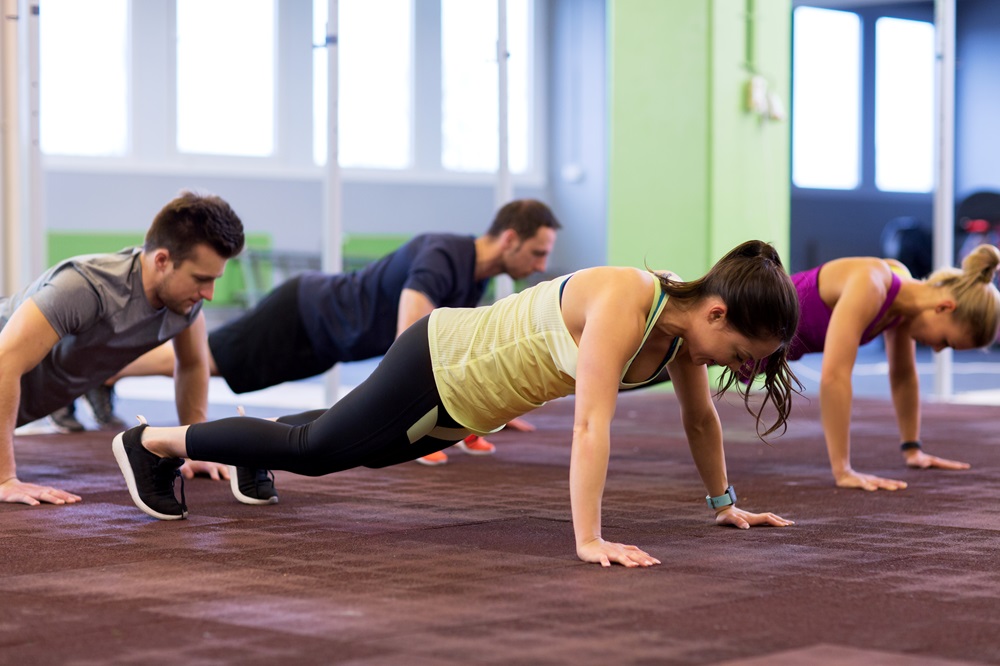Burpees – what kind of exercise is it? Benefits, technique, and tips

Burpees are a full-body exercise that engages multiple muscle groups simultaneously. They can help reduce body fat while also improving strength, endurance, and coordination. This workout combines several popular movements into a high-intensity aerobic exercise. It’s one of the most effective fitness activities that requires no equipment, relying solely on the athlete’s body weight. What exactly are burpees? How do you perform them? What benefits does the “drop and jump” exercise offer?
Table of contents
- What are burpees?
- Benefits of burpees - what does this intense exercise offer?
- Burpees - fat-burning exercise
- How to perform burpees correctly?
- Common burpees mistakes
- Burpees variations
- How to include burpees in your workout? Effective ways to boost fitness
- When should you avoid burpees? Contraindications and risks
What are burpees?
Burpees, also known as squat thrusts or squat jumps, are a compound, full-body exercise consisting of four movements: squat, plank, push-up, and jump. This exercise combines strength, endurance, and aerobic elements, working muscles including the abdominals, chest, glutes, quads, hamstrings, triceps, and shoulders.
Burpees were developed in the 1930s at Columbia University by American physiologist Royal H. Burpee as a simple fitness test to objectively assess physical condition. Originally, the test included four movements performed in different positions combined with five heart rate measurements. Due to interest from the United States Armed Forces, the test was modified by removing the heart rate checks and combining the recommended movements into one sequence. This change allowed thousands of recruits to be quickly evaluated during World War II.
Benefits of burpees - what does this intense exercise offer?
Burpees are well known among CrossFit enthusiasts and fitness lovers as an exercise that improves overall fitness while boosting endurance and agility. Regular practice can increase strength and stamina. Additionally, including burpees in a training plan can enhance cardiovascular and respiratory function.
After a month of consistent burpee training, you can expect stronger core muscles – key for maintaining proper posture – as well as a firmer, more toned physique, which supports achieving your desired shape. This activity, developed by an American physiologist, also improves coordination and reduces the risk of back pain, injuries, and strains during other physical activities.
Burpees - fat-burning exercise
Burpees are a dynamic workout that can support weight loss and fat reduction by increasing metabolism and enabling efficient fat burning.
Depending on factors like age, weight, exercise intensity, and the burpee variation practiced, an individual may burn up to 100 calories in 10 minutes of burpees. This makes them very popular among people aiming to shed excess pounds and improve their body composition.
How to perform burpees correctly?
You don’t need to do 100 burpees a day to see positive effects on your body. However, proper technique is crucial. Before adding burpees to your daily routine, it’s important to master the correct form to increase exercise effectiveness and prevent injuries.
- Start standing with your feet hip-width apart. Keep your back straight, arms relaxed by your sides, and knees slightly bent.
- Lower into a deep squat by bending your knees and dropping your hips.
- Place your hands on the floor slightly wider than shoulder-width and lean forward, shifting your weight onto your hands.
- Quickly jump your feet back into a plank position, keeping your body in a straight line from head to heels with arms fully extended.
- Lower your chest and perform a push-up, making sure your elbows point slightly outward.
- After the push-up, pull your knees toward your chest, returning to the squat position.
- Finish with an explosive jump straight up, raising your arms overhead.
- When landing, bend your knees to soften the impact and touch the ground with your toes, then the balls of your feet, and finally your heels. Repeat the entire sequence from the beginning.
Common burpees mistakes
When practicing the “drop and jump” exercise, focus on proper technique. Common errors include:
- irregular breathing
- arching the lower back
- raising the hips too high during the plank
- pausing mid-sequence or stopping during the exercise
- starting too fast, causing breathlessness and inability to finish
- shallow squats
- placing hands too wide
- insufficient lowering of the body.
Burpees variations
Burpees are a versatile exercise that can be adapted in many ways to suit individual goals, fitness levels, and experience.
The classic burpee uses only body weight, but alternatives include using dumbbells, kettlebells, or resistance bands.
Some common variations are:
- burpees without the jump, where you may simply rise onto your toes at the end
- deadman burpees, where you lie flat with arms extended during the push-up
- burpees with jumping jacks after the push-up
- burpees without a push-up, holding the plank position longer. Burpees with a box jump, adding a jump over a box to the sequence.
How to include burpees in your workout? Effective ways to boost fitness
Burpees can be added to your training plan in two ways: by performing a set number of repetitions or by doing as many reps as possible within a set time. Tabata training often includes burpees as one of the exercises, as do circuit and HIIT workouts.
Burpees are demanding but worth including 2–3 times a week to significantly improve endurance and fitness. Besides regular workouts, proper supplementation can support athletic performance. For strength and aerobic athletes, creatine, protein, or comprehensive pre-workout supplements may be helpful.
When should you avoid burpees? Contraindications and risks
Although burpees benefit many, they are not suitable for everyone. People with spinal degeneration, balance disorders, or varicose veins should avoid them.
They’re also not recommended for those with joint or ligament problems, diabetes, heart or circulatory conditions without consulting a doctor, pregnant women, and individuals with obesity, for whom burpees might be too strenuous.

